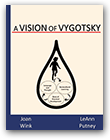Dear WinkWorld Readers,
A colleague and I were discussing scaffolding, which led me to review some of my materials. The purpose of this post to share a few materials on scaffolding.
First, what is scaffolding?
Scaffolding is how we structure our strategies to make content more comprehensible and compelling for students. Scaffolding is the gradual withdrawal of the teacher’s pedagogical support when a student moves from learning in groups to independent learning and mastery (Roe & Wink, 2012).
Second, why do we, teachers, scaffold learning?
•To lead the learner to her next developmental level
•To make language and content comprehensible and accessible
Scaffolding: The Historical Context
Wood, Bruner, and Ross (1976) coined the term when they wrote about a tutor who was interacting with child and a wooden puzzle of a pyramid. Wood et al state that the two are working on “a ‘scaffolding’ process that enables a child or novice to solve a problem, carry out a task or achieve a goal, which would beyond his unassisted efforts” (p. 90).
http://stanford.academia.edu/RoyPea/Papers/109079/The_Social_and_Technological_Dimensions_of_Scaffolding_and_Related_Theoretical_Concepts_for_Learning_Education_and_Human_Activity
Scaffolding originated with Vygotsky’s notion of the Zone of Proximal Development (ZPD).
What is the ZPD?
. . .the distance between the actual developmental level as determined by independent problem solving and the level of potential development as determined through problem solving under adult guidance or in collaboration with more capable peers (Vygotsky, 1986, p. 86; as cited in Wink and Putney, 2002, p. 86)
Many think of scaffolding in the construction business, but it is now almost a prerequisite skill for all teachers. It is particularly effective with students who are in the process of acquiring a new language.
Third, how can teachers do it with students?
Teachers often think of three phases in the process of scaffolding:
I do (or, the teacher will…)
You do (or, the class will…)
We do (or, the individual will…).
2012 Great Valley Writing Project: I do. You do. We do.
Click here to see this presentation, which begins with scaffolding and moves into TPS (Total Physical Response) and then into TPRS (Teaching Proficiency to Reading through Storytelling).
2012 TESOL in Philadelphia with Dr. Chris Roe
This is the handout, which we shared with the participants at this session.
2012, TESOL: The participants generated this long list of ways of scaffolding with students.







